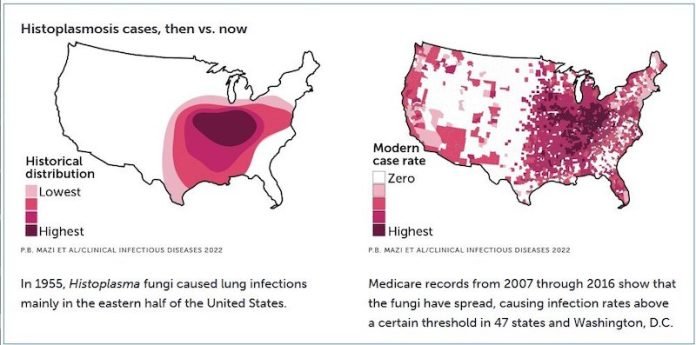
In a study from Washington University in St. Louis, scientists found three types of fungi that cause serious lung infections and were once thought to be confined to certain regions of the United States are now widespread.
In 1955, Histoplasma fungi grew mainly in Midwest soil and in parts of the East and South, and that’s where histoplasmosis infections mainly occurred.
But Medicare records from 2007 through 2016 indicate that 47 states and Washington, D.C., had cases of histoplasmosis above a certain threshold.
The team says these fungi are now a lot more common than we think they are.
Doctors using maps from the 1950s and 1960s may fail to diagnose infections in patients who live outside of the fungi’s historical borders. Such missed or delayed diagnoses can have deadly consequences.
The team drew updated maps for Histoplasma cases and for two other fungi whose ranges have expanded, probably because of climate change.
Coccidioidomycosis cases, caused by Coccidioides fungi, have spread from their 1955 roots in the Southwest to 35 states, Medicare records indicate.
Coccidioides include fungi that cause valley fever (SN: 11/29/21). Wildfires have been linked to a rise in valley fever cases in recent years (SN: 4/13/21).
The team found like Histoplasma, Blastomyces was primarily found in the Midwest and East in 1955. But from 2007 through 2016, 40 states reported blastomycosis cases above a certain threshold.
When diagnosing infections, doctors are taught to look for horses, not zebras, meaning tests typically focus on common infectious organisms, not rare ones.
The team hopes the updated maps encourage doctors to test for the fungi more often in patients with lung infections.
If you care about lung health, please read studies about why Viagra may be useful in treating lung diseases, and scientists find herbal supplement to treat lung cancer.
For more information about health, please see recent studies about gum disease linked to impaired lung function, and results showing COVID-19 is not just a respiratory illness, it can cause strokes too.
The study was conducted by Andrej Spec et al and published in Clinical Infectious Diseases.
Copyright © 2023 Knowridge Science Report. All rights reserved.



